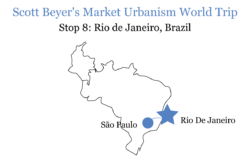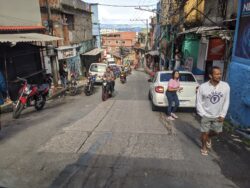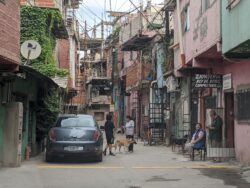Favelas, the Great Untapped Neighborhoods
Here's what I learned visiting some of the most dangerous places on Earth.
During my Global South travels, I go to places most tourists won’t: favelas.
Favela is the Portuguese word for “shantytown”, and while specific to Brazil, describes the informal development style that exists worldwide and has different names by region. Favelas began in the late 19th century when soldiers settled in the hills of Rio de Janeiro. They proliferated from the 1940s to 1970s, when rural Brazilians moved from the countryside to cities. Since people could not afford standard housing, they built these illegal settlements.
Housing within them is low quality. They’re built with whatever is available, like wood scraps, cardboard, metal sheets, or plastic tarps. They lack infrastructure like plumbing and electricity. Sanitation is also an issue, due to lack of clean water and waste disposal systems, as is safety, given how these areas can become gang-controlled.

But favelas aren’t all bad. I think of them as the ultimate “Jane Jacobs” neighborhoods. They have high density, narrow streets and mixed-uses, dominated by sole proprietor businesses. Many are located in great areas, on mountains, near water, and centrally located in cities.
In Brazil, I visited Vidigal. It’s located on the Dois Irmãos hillside, near some of Rio’s wealthiest areas. It was once one of Rio’s most dangerous favelas.
Now, while far from totally safe, it’s tourist-friendly. My cab driver dropped me off at the base of the hill, and paid two “tour guides” in red shirts to take me through Vidigal in their private bus. On the way up, I saw boys in their teens and twenties guarding every corner. Some hold large assault rifles. I was told to not take photos.
But I sure wanted to. Vidigal’s street layout is incredible: narrow, like a maze, with staircases every which way. Retail was abundant—basically one giant street market.

At the top I was even more amazed. There was a bar, hostel, and other tourist attractions overlooking the city and the bay.
Vigidal transformed due to pacification in 2011. To take favelas back from the control of gangs and drug dealers, Brazil created the Pacifying Police Unit, or UPP. According to the Wilson Center, it starts with heavily-armed police surrounding the favela and going after the dealers. In the next phase, which lasts about a month, police search the area around the favela and “stabilize” the community. After that, they install the UPP, which is a tamer set of officers who try to build community trust.
Governments also try to improve favelas by investing in infrastructure. While these areas begin illegally without public support, governments extend services there once they hit a critical population mass. One of the oldest favelas in Argentina is Villa 13, near one of Buenos Aires’ wealthiest areas. Most of its 40,000 residents lack running water, sewage service, and electricity. The government is investing $320 million to improve homes, build a bank, schools, and restaurants. Given the location and design of Villa 13, I think it’s just a matter of time before the real estate becomes valuable.

Another way governments can integrate favelas is through transportation. Comuna 13 in Medellin, Colombia was once among the world’s most dangerous places. High up on a hill and without a connected street network, the only way most residents could get to the city was by walking or taking unreliable buses. It was hard for residents to find work.
In 2004, the government began building gondolas—now called the Metrocable—to connect Comuna 13 to the city. There are three Metrocables that carry 20,000 passengers daily. In 2011, they built a giant, 384-meter covered outdoor escalator to make commuting up and down the mountain easier.
Now, Comuna 13 is a great tourist spot, namely for urbanists, who can safely experience the masterful “unplanning” of an informal settlement.

One might look at these photos and notice that favelas look similar to one another despite being in different countries. It’s not surprising to me, since they all represent how urbanism naturally occurs absent much government regulation or financial resources.
Which brings up the age-old debate about whether favelas are libertarian. In some ways they’re not: these are squatter settlements that don’t have proper land title or other liberal notions of property rights. The fact that gangs control them without voluntary resident buy-in testifies to that.
But favelas have a libertarian spirit. They were built by everyday people, not central planners. They represent unregulated, emergent urbanism, where people conduct business based on consumer need, not large elite civic visions. Their tight confines speak to the spatial tradeoffs that people in a market system make to achieve highest and best use of land. Why build a street or alley wider than it must be when that space can generate profits? Not until governments get involved do urban spaces become wider and more standardized (aka less economically efficient).
Favelas’ path to future prosperity also does not fall along strictly private vs. public lines—it’s some of both. I view these neighborhoods as successful relative to how they started, and that’s due to their robust private sectors. But to reach the next level, it does seem that government bureaucracies must address their current collective action shortcomings, such as lack of police and sanitation.
But city governments shouldn’t take that thinking too far. Parts of New York, Boston and other desirable U.S. cities were once considered slums—and razed accordingly. But some of the ones that missed the wrecking ball are now among the most expensive places in the U.S.
I see the same potential for LatAm favelas if they ever get some normalized level of services. Underneath these small business ecosystems and Jacobian “urban bones” is immense untapped value.
All images credited to Scott Beyer and The Market Urbanist.
Catalyst articles by Scott Beyer | Full Biography and Publications
